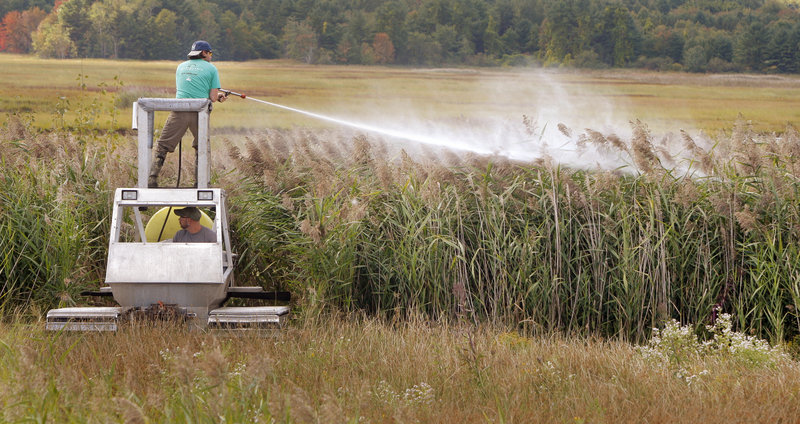SCARBOROUGH — From his perch atop the amphibious vehicle, Colin Avery takes aim at a stand of invasive reeds off Route 1. He sprays an herbicidal solution that represents the first volley in a three-year effort to dramatically reduce the presence of Phragmites australis in the Scarborough Marsh.
The contractor crew is wrapping up its first application of herbicides. It has been attacking invasive Phragmites stands from the Marsh Master, a vehicle equipped with pontoons and treads that make it look a bit like a tank.
In the winter, the crew will return with a mowing attachment on the vehicle to remove dead Phragmites and make way for native species that have been crowded out by the prolific intruder. The process will be repeated as needed over the next two years, at which point the amount of invasive Phragmites could be reduced by as much as 95 percent.
There’s a small window of time – from the end of the growing season to the first killing frost – that is the best time to apply the herbicide. The plants are pulling sugars and starches into their root systems in preparation for the winter, and the herbicides – glyphosate and salt of imazapyr, sold under the brand names Accord and Habitat, respectively – will be drawn in with them, said Kurt Ehrhart, owner of IMM Inc., the Madison, Conn.-based contractor hired by the state Department of Inland Fisheries and Wildlife.
Ehrhart and his crew travel along the East Coast at this time of year, hitting sites of Phragmites invasions. The reed has taken over 90 percent of some areas. The Scarborough Marsh is much better off, with only 100 of its 3,200 acres covered, Ehrhart said.
“This is more a proactive approach,” he said.
This is not the first attempt to control Phragmites in the marsh, which is considered Maine’s most significant salt marsh. Because Phragmites prefers fresh water – including runoff from developed areas – past efforts have focused on enlarging culverts and plugging ditches to increase the flow of saltwater. Smaller-scale eradication efforts left large stands untreated because of the expense.
Phragmites, with its characteristic large seed head, is so common around the marsh that many people believe it is indigenous. In fact, there are only about three acres of the native variety, which is shorter, grows less thickly and has red coloring and spots on its stems.
Phragmites australis grows so densely that it excludes plants that are valuable to wildlife, including the salt hay that forms the base of the food chain.
The availability of funding made the current three-year project possible. Most of the $70,000 comes from a federal Department of Agriculture program for wildlife habitat improvement.
At the end of the contract, the expectation is that Inland Fisheries and Wildlife staff members and volunteers will be able to manage the remaining Phragmites, said Scott Lindsay, a wildlife biologist for the department.
“It’s always going to be an issue,” he said.
Staff Writer Ann S. Kim can be contacted at 791-6383 or at: akim@pressherald.com
Send questions/comments to the editors.



Success. Please wait for the page to reload. If the page does not reload within 5 seconds, please refresh the page.
Enter your email and password to access comments.
Hi, to comment on stories you must . This profile is in addition to your subscription and website login.
Already have a commenting profile? .
Invalid username/password.
Please check your email to confirm and complete your registration.
Only subscribers are eligible to post comments. Please subscribe or login first for digital access. Here’s why.
Use the form below to reset your password. When you've submitted your account email, we will send an email with a reset code.